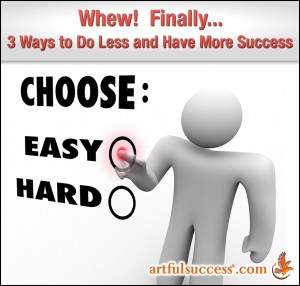 The creative process often has bumps in the road. It’s like setting out on a road trip. You have no idea if there are going to be traffic jams, accidents, weather delays, etc. So you go with the flow, hoping for the best.
The creative process often has bumps in the road. It’s like setting out on a road trip. You have no idea if there are going to be traffic jams, accidents, weather delays, etc. So you go with the flow, hoping for the best.
Very few of us have the luxury to just create whenever and for no reason other than pure enjoyment without a goal, deadline, or reason in mind.
If you are a hobbyist, with a full-time job, it’s likely you squeeze your creation time in during your evenings and weekends. If you are in business in a creative field, you probably only spend 30-35% of your time actually doing your genius work or creating.
The rest of the time is spent on business, marketing, selling, and shipping. (if you aren’t spending 65-70% of your time on these areas, I hope it’s because you have a team doing it).
It is no surprise that creative types are also not the most organized or productive. It’s not how we “roll”… or more specifically, how our brain works!
We don’t particularly like systems, schedules or processes that are redundant and repeatable. But we all have deadlines and they creep up on us quicker than we prefer.
When working on a project, or trying to innovate something new, there are processes that will help you achieve success. Would it surprise you that it’s about what you don’t do than about adding more?
3 Ways to Edit and Do Less to Create Success
As Mies van der Rohe said “Less is More”. Constraining the parameters of a project can create a focus and drive where more options, more time, and more money equates to having too many cooks in the kitchen.
1. Stop Creating One Big Deadline
When we create one big final deadline date, it’s so oppressive that it overwhelms us. We spend the beginning of the project time procrastinating. Too much research, analysis, and contemplation = paralysis.
Then, when we realize we’ve wasted far too much time, we decide we have to actually start to take action, but by then we really are under the gun to meet it’s due date. Or worse we lose interest in our project.
So what can you do? Instead of one big deadline, install several small deadlines. Over the course of a month you could have a Friday deadline which then gives you 4 deadlines instead of one. This levels out the intensity, stress and keeps expectations reasonable.
2. Narrow the Goal
Spend some quality time brainstorming about the project. I love to use Post-it® notes on a wall, mirror or white board. I can then rearrange them, move them or toss them.
Once you rest on the design process (or action steps/components) the Post-it® note process allows you to move them into a work flow “chart”. This is the time to add in extra sticky notes to further break down the steps into the small doable actions.
Edit out unnecessary components or steps of the project. Editing is the best quality, and the hardest quality, of a designer or creator. Saving on materials, steps, processes, or extras will make your product or program more affordable, effective, with a larger profit margin.
3. Tackle the Easiest Action First
Then pick the easiest one (Post-it® note action step) and tackle it. Then the next etc.
Snack-size actions, done in succession with consistency = success.
Celebrate each step completed!
Constraining your project and activating these processes will help you accomplish the deadlines faster with optimal outcomes in your design.






Now you tell me! I’m kidding. I’ve been following you for awhile but wish I had followed more closely. The big deadline is here. Guess I’d better get off the computer–but you’ll be hearing from me in the New Year.
This is a fabulous post, Tonya. Very practical and useful advice from a lady who Gets Stuff Done!
This is a great post – project management for artists!